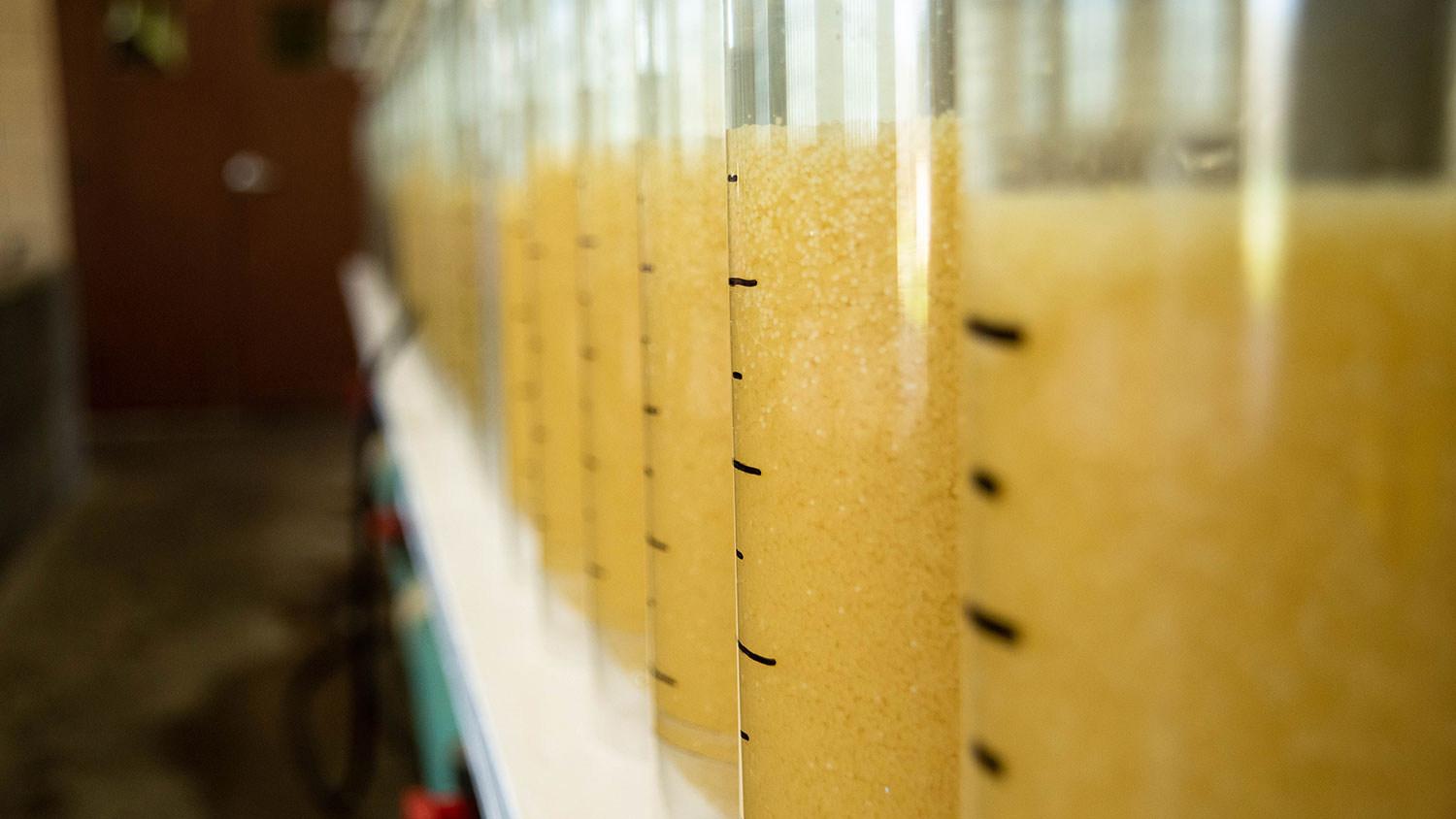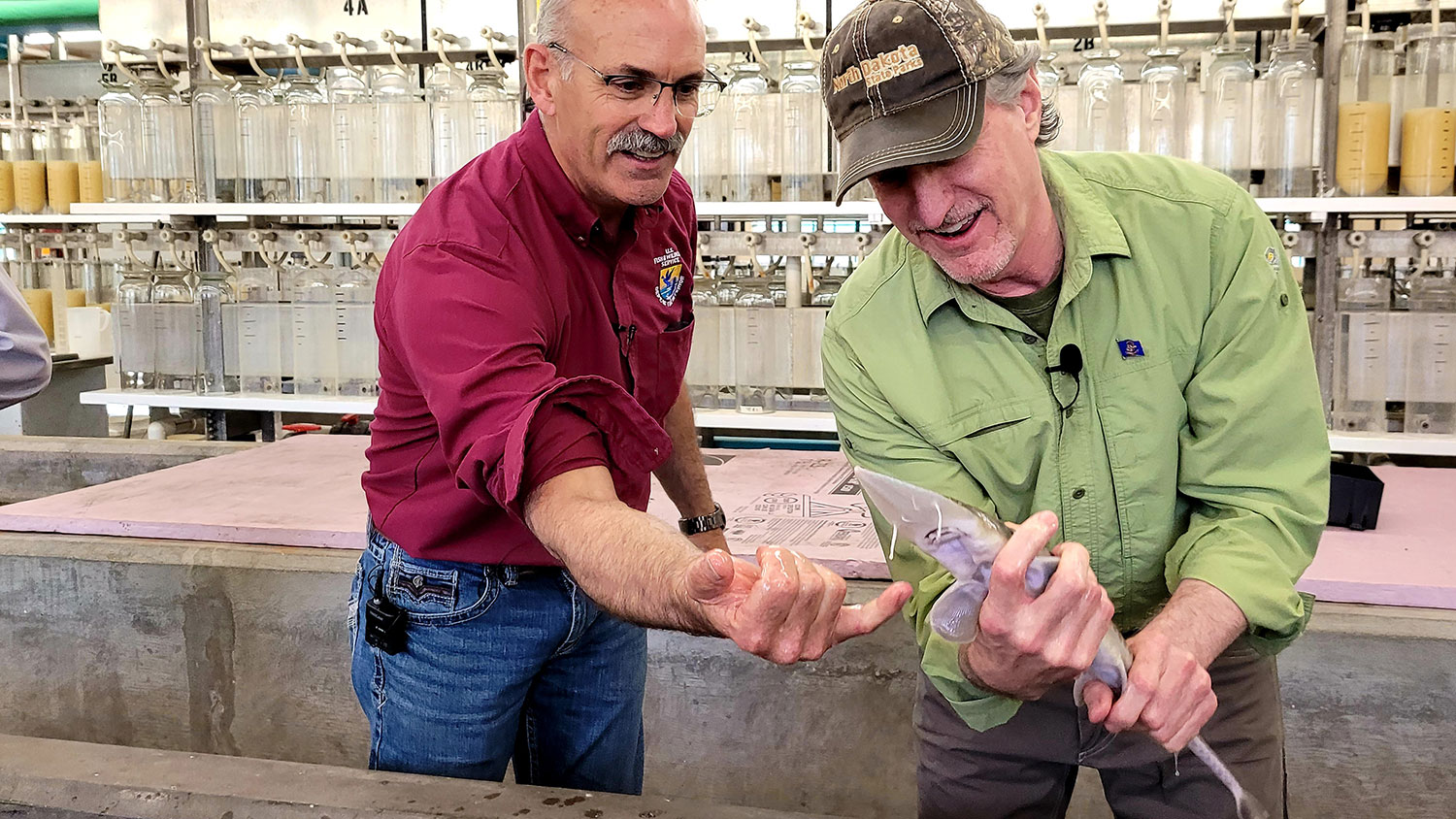
Model Partnership

Walleye eggs rest in incubation jars inside the hatchery for roughly two to three weeks before the tiny, hatched fish are released into outdoor ponds.
Since 1989 when the North Dakota Game and Fish Department invested $5 million on infrastructure at Garrison Dam National Fish Hatchery to increase fish production, agency personnel have stocked more than 248 million walleyes in state waters and 2 million pounds of trout and salmon.
Anglers, you’d have to imagine, have to be happy with the 32-year return on that investment.
This unparalleled production, especially when you compare the number of walleyes raised and released in other states, is possible because of the decades-long, matchless working relationship between the Department and the U.S. Fish and Wildlife Service.
“We have worked literally shoulder to shoulder with hatchery personnel for years with virtually no conflict,” said Greg Power, Game and Fish Department fisheries chief. “In the end, everybody benefits from that type of relationship.”
Yet, like in anything in life, change is certain.
“After 26 years here and 30-plus years with the U.S. Fish and Wildlife Service, I’ve decided to retire and go out with my grandkids and actually take advantage of some of those fish we’ve been stocking,” said Rob Holm, project manager for Garrison Dam and Valley City national fish hatcheries.
Jerry Weigel, Game and Fish Department production/development section supervisor, has worked with hatchery personnel for years and is certain staff from both agencies will adjust with the change.
“When somebody leaves like Rob, you’re losing a lot of experience,” Weigel said. “We have an amazing demand for fish right now, which puts a lot of pressure on the hatchery. But they’re very talented folks and we have such a help-each-other-out atmosphere that I’m certain things will get done.”

Russ Kinzler, with the Game and Fish Department, waits atop the Department’s fish distribution trailer for a net of walleye fingerlings from Ben Oldenburg with the U.S. Fish and Wildlife Service.
Personnel from both agencies bring different skills to the partnership. State fisheries biologists provide the know-how in egg-collecting, fish-hauling and a thorough knowledge of North Dakota waters. Conversely, the hatchery has disease experts and the wisdom of raising fish.
“We are all working on the same goal of making fishing better across the state, regardless of what uniform we wear, or the different patches on our sleeves,” Weigel said. “They want to produce great, healthy fish, and lots of them, and we want to make sure we’re getting them to the lakes and providing the proper management that makes for the best fishing we can possibly provide.”
Holm said the working link between the Game and Fish Department and the federal hatcheries in North Dakota stands as a scarce model around the country.
“Typically, you have your federal hatcheries and you have your state hatcheries and they really don’t mix. They each have a different purpose, but it shouldn’t be that way,” Holm said. “There is so much opportunity when we work together. What we’re doing in North Dakota should be a model for the rest of the states.”
Garrison Dam and Valley City hatcheries are critical to North Dakota fishing because the fish populations in many waters are just not self-sustaining. And with many more waters on the landscape today than when Holm moved to the state in about the mid-1990s, the demand to produce and stock walleye keeps climbing.
“People need to keep in mind the number of fish we stock isn’t driven by what the hatchery can produce, it’s driven by need,” Weigel said. “Thirty years ago, we only needed 3 to 5 million walleyes because we had fewer than 200 lakes to stock. Today, we have 450 lakes to stock and 10 to 12 million is just barely enough to cover what we need to do.”
Walleye, as Holm and other fisheries personnel understand, no matter which uniform shirt they’re wearing, is king in North Dakota.
“I checked into it last year and learned that the next highest production of walleye of any state in the union is around 5 million,” Holm said. “What we’re producing in this hatchery alone compared to that is a big difference, and we do it only because of the cooperative relationship with the Game and Fish.”
Walleye, trout and salmon aside, a number of other fish species have been raised at the hatchery and released into state waters over the years, such as bass, crappie, pike, muskies, paddlefish, the list goes on.
Yet, it shouldn’t be.

Rob Holm, hatchery project manager, points out some of the characteristics of a pallid sturgeon to Governor Doug Burgum.
“There is a whole gamut of fish, including pallid sturgeon used in the recovery effort we’ve been working on for more than 20 years now,” Holm said.
When Holm started at the hatchery, they had a single tank in a storage facility where they would hold endangered pallid sturgeon before shipping them south to another hatchery in South Dakota. The recovery effort needed a boost as it was estimated that there were just 200-250 adults remaining in the wild.
“So, getting that program going, taking it from a storage shed and putting it into a production building where like 80% of the pallid sturgeon stocked nationwide came from … that’s something,” Holm said. “It’s pretty remarkable being able to take that fish that was on the brink of extinction and reestablishing those populations up and down the Missouri and Yellowstone rivers.
“Those fish will be here when my grandchildren have kids,” he added. “I think that’s kind of a big thing. I didn’t want to see that fish to go extinct on my watch and it won’t.”
Power applauds the balancing act Holm and staff have demonstrated over the years dealing with the state’s recreational fishing needs and management of native species.
“They have been dealing with a number of species that we don’t put on our dinner plates, but we certainly care that they are out there,” Power said. “The pallid sturgeon, of course, is the poster child, but there are so many other species that Rob and the hatchery system deal with that are also important to North Dakota.”
